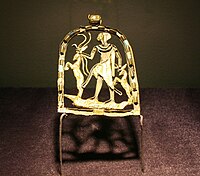Pectoral with the patron god Sched
| Pectoral with the patron god Sched | |
|---|---|

|
|
| material | gold |
| Dimensions | H. 6.9 cm; W. 5.2 cm; T. 0.8 cm; |
| origin | unknown |
| time | New Kingdom , 18th dynasty to 20th dynasty , 1550 to 1070 BC Chr. |
| place | Hildesheim , Roemer and Pelizaeus Museum , PM 5922 |
The pectoral with the patron god Sched from the New Kingdom (18th to 20th Dynasty, approx. 1550 to 1070 BC) belongs to the Egyptian collection of the Roemer- und Pelizaeus-Museum Hildesheim . This elaborate piece of jewelry, which was worn as a neck pendant, pectoral or amulet , appears in men's burials in the New Kingdom that are directly related to the deceased.
origin
The pectoral was acquired by the museum in 1987. The circumstances of the find are unknown.
description
The object is made of gold and has colored stone inlays. It is 6.9 cm high, 5.2 cm wide and 0.8 cm deep. The magically effective protection that emanated from the representation of this pectoral was equally desired in this world as in the hereafter . The delicate, horseshoe-shaped frame made of sheet gold, which represents a chapel and is provided with colored inlays, encloses a picture of the patron god Sched . The motif is finely chased on the back. The name of the god Sched means “savior” and can actually refer to any deity who is called upon for help. Since the 18th dynasty, this general protective aspect has been personified in a separate deity, which was connected primarily to the figure of the youthful Horus as the son and avenger of Osiris . From Horus Sched got his youthfulness and the " youth lock ". He wears the prince's apron, which is getting tighter at the front, with a high girdle at the back and two fluttering ribbons, a wide collar and bracelets and is dressed like a prince of the New Kingdom. The princely god is adorned with an arm band and a four-row chest collar. His attribute is the quiver with arrows that he carries over his shoulder. With both hands he grabs snakes and gazelles, representing the desert animals. The god walks over two crocodiles that look antithetically outward and rest on a base line designed as a sacrificial mat. In this way, he symbolically subordinates a multitude of powers that could be dangerous to humans, a symbolism that appears on the stelae as well as on pieces of jewelery and has been found on the so-called Horus steles especially since the late period . The creation of the pectoral offered its wearer protection against these dangers, which one not only had to reckon with every day in life, but which also lurked on the dead man's uncertain path to the afterlife.
State of preservation
The pectoral is almost completely preserved except for the red inlays on the upper body and limbs, which have been lost.
literature
- Bettina Schmitz : Pectoral with the protective god Sched . In: Arne Eggebrecht (Hrsg.): Search for immortality. Cult of the dead and belief in the afterlife in ancient Egypt . von Zabern, Mainz 1990, ISBN 3-8053-1224-5 , p. 76-77 (catalog manual).
- Arne Eggebrecht : Pelizaeus Museum Hildesheim. The Egyptian Collection. von Zabern, Mainz 1993, ISBN 3-8053-1579-1 , p. 68 and Fig. 62.
- Bettina Schmitz: New evidence for the god Sched. Amulet Hildesheim Pelizaeus Museum 5922. In: Betsy Morrell Bryan, David Lorton (Ed.): Essays in Egyptology in honor of Hans Goedicke. Van Siclen Books, San Antonio 1994, ISBN 0-933175-40-X , pp. 255-263.
- Martin von Falck: Pectoral of the god Sched . In: Katja Lembke (ed.): Life on the Nile and everyday life in ancient Egypt (= The ancient Egypt in Hildesheim ). tape 2 . von Zabern, Darmstadt / Mainz 2011, ISBN 978-3-8053-4285-8 , p. 114–115 (catalog for the permanent exhibition).
Web links
- Entry as well as pictures and description at The Global Egyptian Museum
- Roemer and Pelizaeus Museum Hildesheim: Egypt - Life on the Nile
Individual evidence
- ^ Roemer- und Pelizaeus-Museum Hildesheim: Inventory number PM 5922